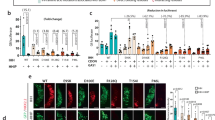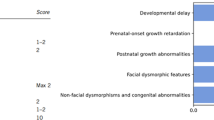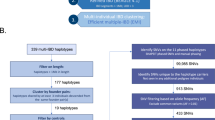Abstract
Mutations in the gene Indian Hedgehog (IHH) that cause Brachydactyly A-1 (BDA1) have been restricted to a specific region of the N-terminal active fragment of Indian Hedgehog involving codons 95, 100, 131, and 154. We describe two novel mutations in codons 128 and 130, not previously implicated in BDA1. Furthermore, we identified an independent mutation at codon 131 and we also describe a New Zealand family, which carries the ‘Farabee’ founder mutation and haplotype. All of the BDA1 mutations occur in a restricted area of the N-terminal active fragment of the IHH and are in contrast to those mutations causing an autosomal recessive acrocapitofemoral dysplasia, whose mutations are located at the distal N- and C-terminal regions of IHH-N and are physically separated from the BDA1-causing mutations. The identification of multiple independent mutations in codons 95, 100, and now in 131, implicate a discrete function for this region of the protein. Finally, we present a clinical review of all reported and confirmed cases of BDA1, highlighting features of the disorder, which add to the spectrum of the IHH mutations.
Similar content being viewed by others
Log in or create a free account to read this content
Gain free access to this article, as well as selected content from this journal and more on nature.com
or
References
Armour CM, Bulman DE, Hunter AG : Clinical and radiological assessment of a family with mild brachydactyly type A1: the usefulness of metacarpophalangeal profiles. J Med Genet 2000; 37: 292–296.
Drinkwater H : An account of a brachydactylous family. Proc R Soc Edinb 1908; 28: 35–57.
Drinkwater H : Account of a family showing minor brachydactyly. J Genet 1912; 2: 21–40.
Drinkwater H : A second brachydactylous family. J Genet 1915; 4: 323–339.
Haws DV, McKusick VA : Farabee's brachydactylous kindred revisited. Bull Johns Hopkins Hosp 1963; 113: 20–30.
Yang X, She C, Guo J et al: A locus for brachydactyly type A-1 maps to chromosome 2q35–q36. Am J Hum Genet 2000; 66: 892–903.
Lodder EM, Hoogeboom AJ, Coert JH, de Graaff E : Deletion of 1 amino acid in Indian hedgehog leads to brachydactylyA1. Am J Med Genet A 2008; 146A: 2152–2154.
Slavotinek A, Donnai D : A boy with severe manifestations of type A1 brachydactyly. Clin Dysmorphol 1998; 7: 21–27.
Tsukahara M, Azuno Y, Kajii T : Type A1 brachydactyly, dwarfism, ptosis, mixed partial hearing loss, microcephaly, and mental retardation. Am J Med Genet 1989; 33: 7–9.
Grange DK, Balfour IC, Chen SC, Wood EG : Familial syndrome of progressive arterial occlusive disease consistent with fibromuscular dysplasia, hypertension, congenital cardiac defects, bone fragility, brachysyndactyly, and learning disabilities. Am J Med Genet 1998; 75: 469–480.
Sillence DO : Brachydactyly, distal symphalangism, scoliosis, tall stature, and club feet: a new syndrome. J Med Genet 1978; 15: 208–211.
Raff ML, Leppig KA, Rutledge JC, Weinberger E, Pagon RA : Brachydactyly type A1 with abnormal menisci and scoliosis in three generations. Clin Dysmorphol 1998; 7: 29–34.
Farabee WC : Hereditary and Sexual Influences in Meristic Variation: A Study of Digital Malformations in Man. Boston: Harvard University, 1903.
Gao B, Guo J, She C et al: Mutations in IHH, encoding Indian hedgehog, cause brachydactyly type A-1. Nat Genet 2001; 28: 386–388.
Armour CM, McCready ME, Baig A, Hunter AG, Bulman DE : A novel locus for brachydactyly type A1 on chromosome 5p13.3-p13.2. J Med Genet 2002; 39: 186–188.
Kirkpatrick TJ, Au KS, Mastrobattista JM, McCready ME, Bulman DE, Northrup H : Identification of a mutation in the Indian Hedgehog (IHH) gene causing brachydactyly type A1 and evidence for a third locus. J Med Genet 2003; 40: 42–44.
Hellemans J, Coucke PJ, Giedion A et al: Homozygous mutations in IHH cause acrocapitofemoral dysplasia, an autosomal recessive disorder with cone-shaped epiphyses in hands and hips. Am J Hum Genet 2003; 72: 1040–1046.
St-Jacques B, Hammerschmidt M, McMahon AP : Indian hedgehog signaling regulates proliferation and differentiation of chondrocytes and is essential for bone formation. Genes Dev 1999; 13: 2072–2086.
Niedermaier M, Schwabe GC, Fees S et al: An inversion involving the mouse Shh locus results in brachydactyly through dysregulation of Shh expression. J Clin Invest 2005; 115: 900–909.
McCready ME, Sweeney E, Fryer AE et al: A novel mutation in the IHH gene causes brachydactyly type A1: a 95-year-old mystery resolved. Hum Genet 2002; 111: 368–375.
McCready ME, Grimsey A, Styer T, Nikkel SM, Bulman DE : A century later Farabee has his mutation. Hum Genet 2005; 117: 285–287.
Liu M, Wang X, Cai Z et al: A novel heterozygous mutation in the Indian hedgehog gene (IHH) is associated with brachydactyly type A1 in a Chinese family. J Hum Genet 2006; 51: 727–731.
Giordano N, Gennari L, Bruttini M et al: Mild brachydactyly type A1 maps to chromosome 2q35–q36 and is caused by a novel IHH mutation in a three generation family. J Med Genet 2003; 40: 132–135.
Nissen KI : A study in inherited brachydactyly. Ann Eugen 1933; 5: 281–301.
Fraser GJ, Bloomquist RF, Streelman JT : A periodic pattern generator for dental diversity. BMC Biol 2008; 6: 32.
Cobourne MT, Miletich I, Sharpe PT : Restriction of sonic hedgehog signalling during early tooth development. Development 2004; 131: 2875–2885.
Vortkamp A, Lee K, Lanske B, Segre GV, Kronenberg HM, Tabin CJ : Regulation of rate of cartilage differentiation by Indian hedgehog and PTH-related protein. Science 1996; 273: 613–622.
Osebold WR, Remondini DJ, Lester EL, Spranger JW, Opitz JM : An autosomal dominant syndrome of short stature with mesomelic shortness of limbs, abnormal carpal and tarsal bones, hypoplastic middle phalanges, and bipartite calcanei. Am J Med Genet 1985; 22: 791–809.
Dixon ME, Armstrong P, Stevens DB, Bamshad M : Identical mutations in NOG can cause either tarsal/carpal coalition syndrome or proximal symphalangism. Genet Med 2001; 3: 349–353.
Gong Y, Chitayat D, Kerr B et al: Brachydactyly type B: clinical description, genetic mapping to chromosome 9q, and evidence for a shared ancestral mutation. Am J Hum Genet 1999; 64: 570–577.
Mangino M, Flex E, Digilio MC, Giannotti A, Dallapiccola B : Identification of a novel NOG gene mutation (P35S) in an Italian family with symphalangism. Hum Mutat 2002; 19: 308.
Takahashi T, Takahashi I, Komatsu M et al: Mutations of the NOG gene in individuals with proximal symphalangism and multiple synostosis syndrome. Clin Genet 2001; 60: 447–451.
Gorlin RJ, Sedano HO, Odont : Cryptodontic brachymetacarpalia. Birth Defects Orig Artic Ser 1971; 7: 200–203.
Holder-Espinasse M, Escande F, Mayrargue E et al: Angel shaped phalangeal dysplasia, hip dysplasia, and positional teeth abnormalities are part of the brachydactyly C spectrum associated with CDMP-1 mutations. J Med Genet 2004; 41: e78.
Hunter AG, McAlpine PJ, Rudd NL, Fraser FC : A ‘new’ syndrome of mental retardation with characteristic facies and brachyphalangy. J Med Genet 1977; 14: 430–437.
Robinow M, Silverman FN, Smith HD : A newly recognized dwarfing syndrome. Am J Dis Child 1969; 117: 645–651.
Zhu G, Ke X, Liu Q et al: Recurrence of the D100N mutation in a Chinese family with brachydactyly type A1: evidence for a mutational hot spot in the Indian hedgehog gene. Am J Med Genet A 2007; 143: 1246–1248.
Acknowledgements
The authors thank the families for their participation and Dr John Christodoulou for his help in arranging the examination of two patients. This work was funded by the Canadian Institute of Health Research (DEB). LR is funded by an Ontario Graduate Studentship.
Author information
Authors and Affiliations
Corresponding author
Additional information
Supplementary Information accompanies the paper on European Journal of Human Genetics website (http://www.nature.com/ejhg)
Supplementary information
Rights and permissions
About this article
Cite this article
Byrnes, A., Racacho, L., Grimsey, A. et al. Brachydactyly A-1 mutations restricted to the central region of the N-terminal active fragment of Indian Hedgehog. Eur J Hum Genet 17, 1112–1120 (2009). https://doi.org/10.1038/ejhg.2009.18
Received:
Revised:
Accepted:
Published:
Issue date:
DOI: https://doi.org/10.1038/ejhg.2009.18
Keywords
This article is cited by
-
Suppression of apoptosis impairs phalangeal joint formation in the pathogenesis of brachydactyly type A1
Nature Communications (2024)
-
Inactivation of Ihh in Sp7-Expressing Cells Inhibits Osteoblast Proliferation, Differentiation, and Bone Formation, Resulting in a Dwarfism Phenotype with Severe Skeletal Dysplasia in Mice
Calcified Tissue International (2022)
-
Deletion of 2 amino acids in IHH in a Japanese family with brachydactyly type A1
BMC Medical Genomics (2021)
-
Altered microRNAs in C3H10T1/2 cells induced by p.E95K mutant IHH signaling
Hereditas (2021)
-
A novel variant of IHH in a Chinese family with brachydactyly type 1
BMC Medical Genetics (2020)



